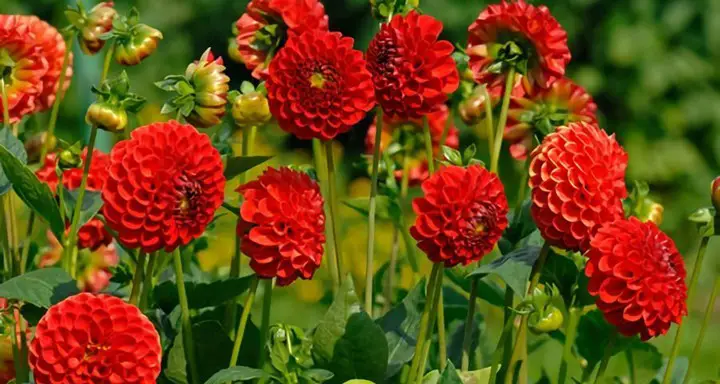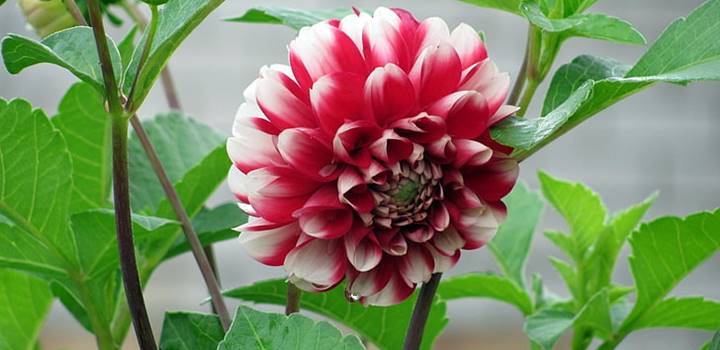Dahlia! A flower that you adore! A flower that brightens your garden. Being a symbol of elegance, it requires special attention.
Dahlia often faces leaf curling problems. Leaf curling is a bit confusing, as it crops up because of diverse reasons.
In Dahlia, leaf curling befalls mainly because of viruses & insects, Improper watering, heat stress & nutrient deficiency also induce curling of Dahlia leaves.
In this article, I have concentrated on these particular reasons and explained them in detail & provided the solutions.
So, if you are thinking about what it means when Dahlia leaves start to curl, you are in the right place!
Let’s dive into it.
Causes Behind the Leaf Curling Of Dahlia & Solutions

1. Virus Attack
Though it is not an animal, nor even a plant, still this tiny little creature causes a diverse variety of diseases to the plants. Yes, I am talking about viruses! Viral infection is a threat for Dahlias. If you ever thought about why the leaves of your Dahlia are curling downward or upward then “virus” is the most presumable answer.
Causes
A genus of the virus world, named Begomovirus, is mainly responsible for the curling of Dahlia leaves.
Have you ever noticed tiny white insects under your Dahlia leaves? Their appearance can be a warning for you! Begomoviruses are transmitted by whiteflies & enter into the leaf cells through the wound made by whiteflies. These viruses reproduce inside the leaf cells of Dahlia using cell substances, take up the cell space & interrupt cellular activities. By & by, the curling of leaves takes place.
Symptoms
- Downward Curling of Dahlia leaves
- Dark & swollen veins
- No bud initiation for a longer period
- Stunted growth of your Dahlia.
Control Measures
Once the leaves are affected, it is impossible to control. That’s why, without further ado, separate the infected plant from other plants.
Preventive Measures
Prevention is the most ideal choice to dodge viral infection. Ensure the following-
- If you grow your Dahlia from seeds, ensure virus-free seeds.
- You can enclose your dahlia with a mosquito net, to keep it safe from whiteflies. Otherwise use a Dahlia insecticide. I am suggesting one of the best insecticides (our pick: Monterey LG6138 Garden Insect Ready to Spray Insecticide/Pesticide)
- Neem oil (our pick: Neem Bliss 100% Pure Cold Pressed Neem Seed Oil) is very efficient against insects! You can spray a mixture of Neem oil after every 7 days to make it vulnerable to insects. Mixture Ratio- 1 tablespoon of Neem oil into 2 liters of water. Don’t forget to spray both the upper & lower part of the leaves thoroughly.
- Use disinfected tools while gardening.
2. Insect Attack
Do you know that around 80% of the world’s total species are insects? Surprising, right?
This abundance of insects generates unsafe circumstances for plants. If your Dahlia leaves start curling & you get confused thinking “what’s wrong with the Dahlia leaves”, then look for the insects! Insects that cause leaf curling of Dahlia are-
- Aphid
- Whitefly
- Mite &
- Thrips
Causes
These insects damage the upper layer of leaf cells & feed cell sap. This feeding mechanism causes leaf curling of your Dahlia. Dahlia Leaves curl upward or downward considering the location of feeding.
Generally, Aphids feed on the lower side of the leaves causing downward curling of Dahlia leaves. On the other hand, thrips feed on the upper side of the leaves causing upward curling.
Symptoms
- Upward or Downward curling of Dahlia leaves.
- Stunted growth
- A Sticky & shiny layer clarifies the presence of aphids. The shiny object is honeydew. It is produced by aphids while feeding! Interesting, isn’t it?
- Discolored small patches of the leaves mark the presence of thrips.
- Mites make webs on the corner or underneath the leaves
- Whiteflies usually reside on the lower side of the leaves.
Control Measures
- Organically, neem oil is the best. If the infestation is not that high, spray neem oil after every 7 days. The mixing ratio is 1 tablespoon of neem oil into 2 liters of water.
- In case of high infestation of insects, inorganic insecticides for Dahlia are effective. Spray thoroughly according to the directions of your insecticide once a week. Normally 2 or 3 doses ensure the total removal of insects. The best time for spraying is early morning or early evening. If you want my suggestion, give this a try. (our pick: Monterey LG6138 Garden Insect Ready to Spray Insecticide/Pesticide)
- There is a very effective insecticide that you can make in your home. The formula is- “Blend 50 gms of garlic pest & 50 gms of yogurt together. And mix the pest with 1 liter of water”. One thing worth mentioning is that, after preparing the mixture, let it stay for at least 7 days before spraying.
Preventive Measures
- Yellow or blue sticky traps are very effective to control these insects. But remember to set the trap keeping little distance with you Dahlia.
- If possible, try to enclose your Dahlia with a net.
- Keep your garden clean.
Now, if you are thinking about how you would differentiate between a virus attack & an insect attack, then let me simplify it for you.
If most of the leaves of your Dahlia start curling, then you may consider it as a virus attack. But if the infected leaves are scattered; for example- if one branch carries some, & other branch carries some of the curled leaves, then your Dahlia is facing an insect attack. Got it?
3. Improper Watering
I won’t be surprised if you are a little bewildered by the watering issues. Almost every gardener goes through this. At least once!
Dahlias start to curl their leaves in response to both over & under-watering.
Causes
Overwatering causes root rot of your Dahlia. Because of root rot, both water & nutrient uptake reduces. On the other hand, under watering ensures less supply of water too.
Now, if you are familiar with the term “Transpiration”, you may know that plants lose water in the form of vapor. Whenever the loss of water surpluses the supply of water, Dahlia curls its leaves to retain moisture.
Symptoms
- Downward curling occurs at the tip & margin of the Dahlia leaves
- In case of overwatering, leaves turn a little yellowish
- Leaf wilting takes place.
Control Measure
- In case of overwatering, stop watering at least for 2 days. Let the topsoil dry out.
- Dahlia needs deep watering twice or thrice a week. This watering schedule is ideal for both under & overwatering.
- Ensure weeding after regular intervals.
Preventive Measures
- Keep watering according to schedule and time.
- Check after a while, whether the drainage system is properly working or not.
4. Nutrient Deficiency
Nitrogen, Phosphorus & Potassium are three important nutrients for any plant, right? Dahlia is not out of that league too but it especially loves potassium.
Causes
While too much nitrogen causes excess growth but little bloom, high potassium promotes blooming. That is why Dahlias are potassium lovers & deficiency of potassium causes leaf curling in Dahlia.
Symptoms
- Curling of leaf tips
- Chlorosis of leaves between veins
- Brown edges in the leaves
Control Measure
- Start fertilizing with N: P: K ratio of 5:10:10 or read this article to learn in detail about fertilizing.
Preventive Measures
- Grow variety with efficient potassium uptake ability.
- Nutrient uptake depends on the proper pH of the soil. The optimum pH for Dahlia is 6.6-7. Therefore, Keeping precise pH is important.
- Water plants accurately.
- No need to fertilize before sprouting. Provide fertilizer to your Dahlia after every 3 weeks from summer to autumn.
5. Heat Stress
It is not easy for plants to arrange an umbrella whenever there is a scorching sun or unbearable heat. As a native Mexican, Dahlias like 26-27 degrees Celsius on average. Well, like us, plants also need shades during too hot temperatures.
Causes
Evaporation from the leaf surface increases with the temperature. To avoid the possibility of losing too much water considering the supply of it, Dahlias make an impressive adaptation. They curl their leaves to retain moisture. Interesting, right?
This whole phenomenon only occurs when Dahlias remain exposed constantly to over 28 degrees celsius.
Symptoms
- Leaves curl upward mostly
- Upper leaves are mostly affected
Control Measures
- To lower the temperature, you can increase humidity by simply spraying water mists to the foliage.
- You can use a humidifier to increase the humidity too.
- If possible, arrange a temporary shade for your Dahlia.
- Do not provide fertilizer during heat stress.
Preventive Measures
- Grow a native cultivar, which is already adapted to the environment of your surroundings.
- Keep updated about the temperature so that you can be prepared beforehand.
Conclusion
Dahlias always give me a vibe of change and creativity. I honestly believe that Dahlias should be embraced, Should be cared for.
As you have come so far, now you know why the leaves of your Dahlia are curling.
You know the causes, you know the solutions. So what are you waiting for?
Diagnose the indications, set the measures & bless your garden with delightful Dahlias.
I hope you find it helpful. Thanks for stopping by!
Read More
